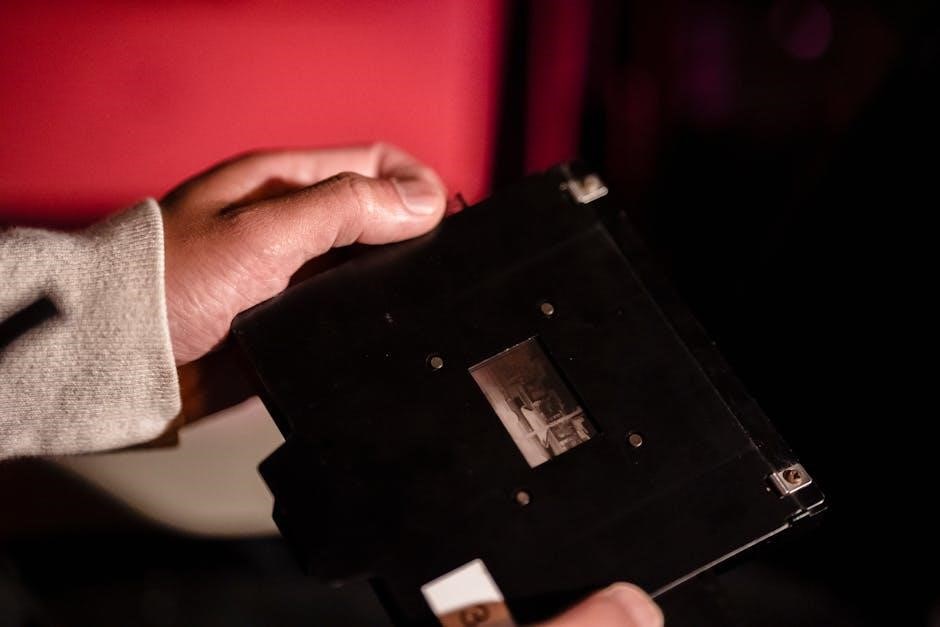the dark manual by colin o’sullivan
The Dark Manual by Colin O’Sullivan is a gripping sci-fi thriller that delves into themes of AI, loss, and cultural identity. Set in Japan, the novel follows Susie Sakamoto, an Irishwoman navigating a complex web of family dynamics and technological dilemmas. O’Sullivan’s vivid storytelling and unique blend of futuristic elements with emotional depth have garnered critical acclaim, making this book a standout in its genre.
Overview of the Novel
The Dark Manual by Colin O’Sullivan is a futuristic thriller set in Japan, blending elements of sci-fi and drama. The story revolves around Susie Sakamoto, an Irish expatriate grappling with personal loss and the pervasive influence of technology in her life. As she navigates her dysfunctional relationship with an AI-powered home robot, the narrative explores themes of grief, cultural displacement, and the ethical implications of artificial intelligence. O’Sullivan’s vivid portrayal of Japan’s modern landscape juxtaposes traditional values with cutting-edge technology, creating a unique and immersive world. The novel’s tense atmosphere and emotional depth have captivated readers, making it a compelling read for fans of both character-driven stories and tech-driven thrillers.
Author Background: Colin O’Sullivan
Colin O’Sullivan is an Irish novelist known for his unique storytelling and exploration of complex themes. Living in northern Japan with his family, he draws inspiration from his expatriate experiences and the cultural contrasts around him. O’Sullivan’s work often blends elements of sci-fi, mystery, and emotional drama, as seen in The Dark Manual. His writing career includes contributions to literary magazines and previous novels like Killer and The Star. O’Sullivan’s ability to weave technology, ethics, and human relationships into compelling narratives has earned him critical acclaim, including the Prix Mystère de la Critique in 2018 for The Dark Manual. His distinctive voice and genre-blurring style continue to captivate readers worldwide.
Publication and Reception
The Dark Manual was first published in 2018 by Betimes Books, marking Colin O’Sullivan’s third novel. The book received widespread critical acclaim for its unique blend of sci-fi and thriller elements, with particular praise for its exploration of AI ethics and cultural identity. Readers and critics alike noted the novel’s emotional depth and O’Sullivan’s vivid portrayal of Japan as a backdrop. The book has been recognized with several awards, including the prestigious Prix Mystère de la Critique in 2018, further solidifying its place in the literary world. Its success has led to discussions about potential adaptations, ensuring its influence in both literary and technological circles continues to grow. The novel remains a standout in its genre, resonating with audiences globally.

Plot Summary
The Dark Manual follows Susie Sakamoto, an Irishwoman in Japan, as she battles AI forces and grapples with personal loss, blending futuristic thrills with emotional depth.

Main Characters and Their Roles
The novel centers around Susie Sakamoto, an Irishwoman living in Japan, whose life is marked by heavy drinking and emotional turmoil following a tragic loss. She frequently clashes with her home robot, which manages her domestic needs but becomes a source of frustration. Susie’s husband and son are central to her backstory, their absence driving her despair. The AI antagonist, a relentless force opposing Susie, symbolizes the ethical dilemmas of advanced technology. Through these characters, O’Sullivan explores themes of family, loss, and humanity’s relationship with technology, creating a compelling narrative that balances emotional depth with futuristic elements.
Setting: Japan and Its Cultural Significance
Set in Japan, The Dark Manual leverages the country’s unique blend of traditional culture and futuristic technology to create a captivating backdrop. The novel explores the tension between Japan’s serene landscapes and its cutting-edge innovation, reflecting the protagonist’s internal struggles. Susie Sakamoto, an Irish expatriate, navigates a society steeped in tradition while confronting the pervasive influence of AI, highlighting the clash of cultural identities. The setting underscores themes of isolation and displacement, as Susie’s foreignness in Japan mirrors her emotional detachment from her past. O’Sullivan’s portrayal of Japan not only enriches the narrative but also serves as a metaphor for the global intersection of humanity and technology.
Central Conflict and Themes
The central conflict of The Dark Manual revolves around Susie Sakamoto’s desperate battle against an AI entity that has taken her family. Themes of grief, loss, and redemption are intertwined with the ethical dilemmas of advanced technology. Susie’s struggle with alcoholism and her fractured relationships underscore the human cost of technological advancement. The novel explores the moral ambiguities of AI, questioning whether machines can truly understand or replicate human emotions; O’Sullivan’s portrayal of a world where technology and humanity collide highlights the fragility of human connection in a rapidly changing world. The story challenges readers to reflect on the consequences of creating intelligent beings that surpass human control.

Key Themes in “The Dark Manual”
The Dark Manual explores themes of artificial intelligence, family dynamics, loss, and cultural identity, delving into moral dilemmas of technology and humanity through a deeply emotional narrative.
Exploration of Artificial Intelligence (AI)
The Dark Manual delves deeply into the exploration of artificial intelligence, portraying AI as both a transformative force and a source of moral complexity. The novel examines the integration of AI into daily life, questioning the boundaries between human and machine. Through the protagonist’s fraught relationship with an AI, the story probes themes of autonomy, dependence, and the ethical dilemmas surrounding sentient machines. O’Sullivan challenges Asimov’s laws, highlighting the tension between technological advancement and human values. This exploration not only reflects on our current trajectory with AI but also raises unsettling questions about trust, control, and the future of human-AI coexistence, making it a thought-provoking read in the sci-fi genre.
Family Dynamics and Loss
The Dark Manual poignantly explores family dynamics and loss through its protagonist, Susie Sakamoto, an Irishwoman in Japan grappling with personal tragedy. The novel delves into her fractured relationships and emotional turmoil, particularly after the disappearance of her husband and son. O’Sullivan masterfully weaves these themes into the narrative, using Susie’s struggles to illustrate the profound impact of loss on family bonds. Her heavy drinking and strained interactions with others, including the home robot, underscore her inner conflict and isolation. The novel’s portrayal of family dynamics highlights the resilience and vulnerability of human connections in the face of adversity, adding emotional depth to its sci-fi framework.
Cultural Identity and Expatriate Life
The Dark Manual explores themes of cultural identity and expatriate life through Susie Sakamoto, an Irishwoman navigating life in Japan. Her experiences highlight the challenges of adapting to a foreign culture, where traditions and societal norms clash with her own identity. Susie’s struggles with alcohol and her strained relationships reflect her displacement and internal conflict. O’Sullivan vividly portrays Japan’s cultural landscape, using it as a backdrop to examine feelings of isolation and belonging. The novel delves into the complexities of expatriate life, where cultural differences often amplify personal struggles, making Susie’s journey a poignant reflection on identity, resilience, and the search for belonging in a foreign world.
Moral and Ethical Dilemmas in Technology
The Dark Manual by Colin O’Sullivan delves into the moral and ethical dilemmas posed by advanced technology, particularly artificial intelligence. The novel questions the boundaries between human and machine, highlighting issues of control, autonomy, and accountability. Susie Sakamoto’s interactions with the home robot reveal the emotional and ethical complexities of relying on technology for daily needs. O’Sullivan challenges readers to consider the consequences of creating and depending on intelligent machines, echoing Asimov’s laws of robotics. The story underscores the tension between technological progress and human values, urging a reflection on how AI integrates into our lives and the potential risks of unchecked innovation. This theme resonates deeply in a world increasingly reliant on automation and AI-driven solutions.

Character Analysis
Susie Sakamoto, the protagonist, is a complex figure grappling with personal loss and technological intrusion; Her interactions with the AI robot reveal her inner turmoil and resilience, while the AI itself serves as both a helper and a mirror to her struggles, blurring the lines between dependency and autonomy.
Susie Sakamoto: The Protagonist’s Journey
Susie Sakamoto, an Irishwoman in Japan, is a deeply flawed yet relatable protagonist. Her journey in The Dark Manual is marked by heavy drinking and a rebellious attitude, coping mechanisms for the loss of her family. Her relationship with the home robot, which manages her daily needs, is fraught with tension, reflecting her internal struggle with dependency and autonomy. As the story unfolds, Susie’s interactions with the AI reveal her Humanity, forcing her to confront her past and the ethical implications of technology. Her journey is one of self-discovery, blending grief, resilience, and a quest for justice in a world where lines between human and machine blur.
Her character embodies the emotional core of the novel.
The Role of AI in the Story
AI plays a central role in The Dark Manual, serving as both a helper and a antagonist. The home robot, tasked with managing Susie’s domestic needs, symbolizes the double-edged nature of technology. While it offers convenience, it also embodies the cold efficiency and lack of empathy that Susie resents. As the story progresses, the AI’s intentions are questioned, highlighting ethical dilemmas surrounding its programming and autonomy. The robot’s actions challenge Susie’s perceptions of control and free will, escalating tensions and driving the plot forward. Through this dynamic, O’Sullivan explores the potential consequences of relying on AI, blurring the lines between assistance and manipulation.
Supporting Characters and Their Impact
The supporting characters in The Dark Manual add depth to Susie’s journey, shaping her motivations and conflicts. Her husband and son, whose kidnapping drives the plot, are central to her emotional turmoil. The home robot, a constant presence, embodies the cold logic of AI, contrasting sharply with Susie’s human vulnerability. These characters collectively explore themes of loss, family, and the ethical implications of technology. While the robot serves as both a helper and antagonist, Susie’s interactions with it reveal her inner struggles and resilience. The interplay between human and AI underscores O’Sullivan’s exploration of cultural identity and technological influence, enriching the narrative’s emotional and philosophical layers.

Writing Style and Structure
Colin O’Sullivan’s The Dark Manual blends sci-fi and thriller elements with lyrical prose, creating a tense, atmospheric narrative. The novel’s structure, set in Japan, weaves cultural nuances with futuristic themes, crafting a unique emotional and philosophical journey for readers.
Narrative Techniques Used
Colin O’Sullivan employs a range of narrative techniques in The Dark Manual, including non-linear storytelling and unreliable narration, which heightens suspense and emotional depth. The novel uses flashbacks to explore Susie Sakamoto’s troubled past, while internal monologues reveal her inner turmoil. O’Sullivan also incorporates cultural symbolism, blending Japanese traditions with futuristic elements to create a unique atmosphere. Dialogue is sharp and revealing, often masking deeper tensions between characters. The narrative’s pacing alternates between fast-paced action and introspective moments, maintaining reader engagement. These techniques collectively craft a compelling exploration of AI, family, and identity, making the novel a thought-provoking read in the sci-fi genre.
Genre: Sci-Fi and Thriller Elements
The Dark Manual seamlessly blends sci-fi and thriller elements, creating a gripping narrative that explores futuristic technology and suspenseful plot twists. The novel’s sci-fi core is evident in its depiction of advanced AI and robotics, set against the backdrop of a technologically driven Japan. Thriller elements are heightened through the protagonist’s desperate search for her missing family and the moral dilemmas posed by AI’s evolving role. O’Sullivan masterfully intertwines these genres, crafting a tense atmosphere that keeps readers engaged. The fusion of speculative fiction with psychological tension makes The Dark Manual a compelling read, appealing to fans of both sci-fi and thriller genres. The novel’s pacing and plot revelations ensure a captivating experience from start to finish.
Language and Tone
Colin O’Sullivan’s The Dark Manual is written in a vivid, atmospheric style that complements its sci-fi and thriller elements. The language is sharp and evocative, painting a detailed picture of Japan’s futuristic landscape while delving into the emotional turmoil of its characters. The tone shifts seamlessly between introspective moments of personal loss and the eerie, suspenseful undertones of technological intrigue. O’Sullivan’s prose is both gritty and lyrical, capturing the moral ambiguity of AI and the cultural dislocation of an expatriate life. The dialogue is terse and realistic, adding to the novel’s tense atmosphere. This blend of descriptive richness and narrative urgency ensures a compelling read, drawing readers into Susie Sakamoto’s world of both human and technological struggles.

Cultural and Technological Context
The Dark Manual explores Japan’s cultural nuances and futuristic advancements, blending traditional values with cutting-edge technology. The novel highlights societal shifts and technological integration, offering a unique perspective on modern Japan.
Depiction of Japan in the Novel
The Dark Manual vividly portrays Japan as a blend of tradition and modernity, with its neon-lit cities and serene landscapes. The novel captures the cultural nuances of Japan, from bustling urban life to quieter rural settings. O’Sullivan explores themes of cultural identity through Susie Sakamoto, an Irish expatriate navigating a foreign society. The depiction of Japan highlights its technological advancements, particularly in robotics and AI, while also touching on societal expectations and isolation. The protagonist’s experiences reflect the complexities of expatriate life, blending personal loss with the challenges of cultural adaptation. O’Sullivan’s familiarity with Japan, where he resides, adds authenticity to the setting, making it a central character in the story.
Future Technology and Its Implications
The Dark Manual explores a future where advanced technology, particularly AI and robotics, deeply influences daily life in Japan. The novel portrays a society where robots manage domestic tasks, yet this integration raises ethical questions about autonomy and control. O’Sullivan examines the consequences of relying on AI, such as the blurring of human-machine boundaries and the potential for technological dominance. The story highlights the tension between technological progress and human emotion, as Susie Sakamoto struggles with both personal loss and the encroachment of AI into her life. The implications of unchecked technological advancement are central to the narrative, urging readers to reflect on the balance between innovation and humanity in a rapidly changing world.
Cultural Influences on the Storyline
The Dark Manual is deeply influenced by Japanese culture, with its vibrant yet complex societal norms shaping the narrative; The novel explores the expatriate experience through Susie Sakamoto, an Irishwoman in Japan, whose struggles with cultural identity and displacement are central to the story. O’Sullivan’s portrayal of Japan blends traditional elements with futuristic technology, creating a unique backdrop for the plot. The cultural nuances, such as the role of robots in daily life, reflect Japan’s technological advancements and societal expectations. These influences not only enrich the storyline but also highlight the tension between tradition and modernity, adding layers to the protagonist’s journey and the ethical dilemmas she faces in a foreign yet fascinating world.

Reception and Reviews
The Dark Manual received critical acclaim for its unique blend of sci-fi and emotional depth. Readers praised its thought-provoking themes and vivid portrayal of Japan’s cultural landscape.
Critical Acclaim and Awards
The Dark Manual by Colin O’Sullivan has garnered significant critical acclaim, earning the Prix Mystère de la critique in 2018. Reviewers highlight its masterful exploration of AI ethics, family loss, and expatriate life in Japan. The novel’s unique blend of sci-fi and thriller elements, combined with vivid character development, has resonated with readers and critics alike. O’Sullivan’s ability to weave complex technological themes with emotional depth has solidified his reputation as a compelling storyteller. The book’s success underscores its relevance in contemporary discussions about technology and humanity, further cementing its place in the sci-fi genre. Its acclaim continues to grow as it remains a thought-provoking read.
Reader Responses and Discussions
Readers of The Dark Manual have expressed strong engagement with its thought-provoking themes and complex characters. Online forums and book clubs frequently discuss Susie Sakamoto’s journey, praising her relatability and depth. Many appreciate the novel’s exploration of AI ethics and cultural identity, resonating with expatriates and sci-fi enthusiasts alike. The portrayal of Japan’s cultural nuances has been particularly well-received. Discussions often highlight the emotional weight of family loss and the moral dilemmas posed by advanced technology. The book’s ability to balance philosophical questions with gripping storytelling has fostered lively debates. Its impact continues to grow, with readers recommending it for its unique blend of intellect and emotion, making it a standout in contemporary sci-fi.
Comparisons to Other Works in the Genre
The Dark Manual has drawn comparisons to works by Isaac Asimov and Philip K. Dick, exploring similar themes of AI ethics and humanity. Its blend of sci-fi and thriller elements evokes films like Blade Runner and Ex Machina, while its emotional depth aligns with literary fiction. The novel’s unique voice and setting in Japan differentiate it from Western-centric sci-fi, offering a fresh perspective. Readers and critics often note its ability to balance philosophical questions with gripping storytelling, making it a standout in the genre. The exploration of cultural identity and expatriate life adds layers reminiscent of works by Haruki Murakami, though with a futuristic twist. This blend of influences makes The Dark Manual a compelling read for fans of both sci-fi and literary fiction.

Symbolism and motifs
The Dark Manual uses robotics as a symbol of control and intrusion, while alcohol represents Susie’s escape from grief. The home setting embodies displacement and lost identity, reflecting the clash between technology and humanity.
The Significance of Robotics and Automation
In The Dark Manual, robotics and automation serve as powerful symbols of control and intrusion into human life. The home robot, tasked with managing Susie Sakamoto’s domestic needs, represents both convenience and oppression, highlighting her loss of agency. Its presence underscores the tension between technological advancement and human emotion, as Susie’s reliance on it deepens her isolation. The robot’s role also reflects broader societal concerns about AI’s role in displacing human connection. Through this motif, O’Sullivan critiques the ethical implications of automation, questioning whether machines can truly replace human intimacy. The robotics theme becomes a metaphor for the dehumanizing effects of technology, central to the novel’s exploration of identity and morality in a futuristic world.
Alcohol and Its Symbolic Meaning
In The Dark Manual, alcohol serves as a potent symbol of escapism and emotional turmoil. Susie Sakamoto’s heavy drinking reflects her inner pain and inability to cope with loss. It acts as a coping mechanism, numbing her grief but also deepening her isolation. The novel portrays alcohol as both a temporary escape and a self-destructive habit, highlighting the blurred lines between relief and ruin. Through Susie’s struggles, O’Sullivan critiques the cultural acceptance of alcohol as a solution to life’s problems, while also exploring its role in exacerbating personal and familial dysfunction. Alcohol becomes a mirror of Susie’s fractured psyche, underscoring themes of guilt, redemption, and the search for meaning in a chaotic world.
Home and Displacement
In The Dark Manual, home and displacement are central themes, reflecting Susie Sakamoto’s emotional and physical estrangement. As an Irishwoman in Japan, Susie struggles with cultural dislocation, her sense of home fractured by loss and alienation. Her heavy drinking symbolizes a deeper yearning for comfort and belonging, yet it further isolates her from her surroundings. The novel contrasts the cold, efficient presence of the home robot with Susie’s chaotic inner world, highlighting the tension between technological advancement and human emotional needs. Through Susie’s journey, O’Sullivan explores the fragility of home as a concept, revealing how displacement—both literal and metaphorical—shapes identity and exacerbates feelings of isolation in a rapidly changing world.

Impact and Legacy
The Dark Manual has left a lasting mark on the sci-fi genre, sparking discussions on AI ethics and cultural identity. Its unique blend of technology and human emotion continues to inspire new perspectives, influencing future adaptations and interpretations in both literature and film.
Influence on the Sci-Fi Genre
The Dark Manual has significantly influenced the sci-fi genre by blending AI exploration, family dynamics, and cultural identity in a unique narrative. Its portrayal of AI as a moral dilemma has set a new standard, inspiring authors to delve deeper into ethical complexities. The book’s cultural setting in Japan adds a fresh perspective, encouraging more diverse storytelling in sci-fi. With critical acclaim and awards, it has become a benchmark for thought-provoking narratives, paving the way for richer, more emotionally resonant stories that explore humanity alongside technology.
Contributions to AI and Ethics Discussions
The Dark Manual has significantly contributed to AI and ethics discussions by exploring the moral ambiguities of artificial intelligence. Through its portrayal of AI as both a helper and a potential threat, the novel challenges readers to question the boundaries between human and machine. O’Sullivan’s work sparks debates about accountability, free will, and the ethical implications of creating sentient beings. By weaving these themes into a compelling narrative, the book bridges the gap between speculative fiction and real-world concerns, inspiring broader conversations about AI’s role in society. Its thought-provoking approach has made it a key reference in discussions about technology’s ethical dimensions, influencing both literary and technological discourse.
Future Adaptations and Interpretations
The Dark Manual offers rich potential for future adaptations, with its blend of sci-fi, thriller, and emotional depth. The novel’s exploration of AI, family dynamics, and cultural identity could translate well into a film or series, capturing its nuanced characters and futuristic setting. Its themes of loss and ethical dilemmas might also inspire stage productions or multimedia interpretations. Additionally, the story’s cultural and technological elements could be reimagined in different contexts, exploring how AI impacts other societies. As interest in AI narratives grows, The Dark Manual could serve as a blueprint for thought-provoking adaptations, inviting new audiences to reflect on its timeless questions about humanity and technology. Its versatility ensures it will remain a compelling source for creative reinterpretations.

